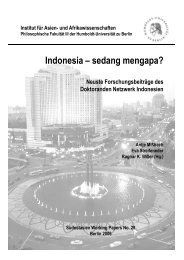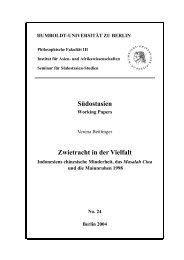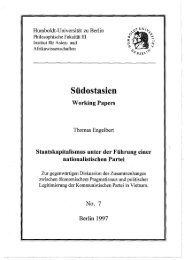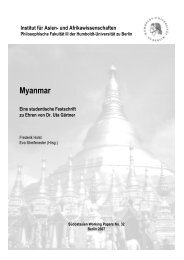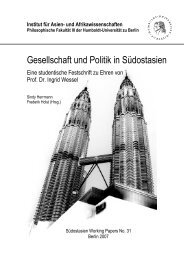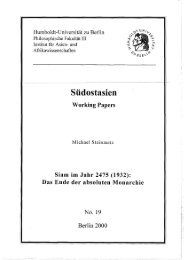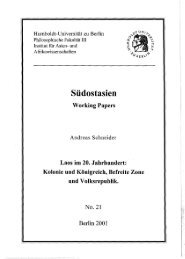On Centrism and Dualism - Humboldt-Universität zu Berlin
On Centrism and Dualism - Humboldt-Universität zu Berlin
On Centrism and Dualism - Humboldt-Universität zu Berlin
Create successful ePaper yourself
Turn your PDF publications into a flip-book with our unique Google optimized e-Paper software.
CENTRISM AND DUALISM<br />
In his seminal work The Elementary Structures of Kinship, LÉVI-STRAUSS (LÉVI-STRAUSS<br />
1969 [1949], 1993 [1969]) conceptualizes marriage as the gift exchange of sisters (daughters)<br />
by brothers (fathers). This conceptualization enables him to develop a concept of exchange<br />
<strong>and</strong> reciprocity of great generality <strong>and</strong> rigor (GREGORY 1994: 925), which is commonly<br />
referred to as LÉVI-STRAUSS’ theory of marriage alliance (cf. e.g. DUMONT 2006: 61 [1971]).<br />
The alliance theory of structuralist anthropologists essentially derives from the Maussian concept<br />
of the exchange of women. Such exchange however, is normally intragenerational or horizontal,<br />
while kinship also involves the equally important intergenerational or vertical dimension (ALLEN<br />
2000: 97).<br />
LÉVI-STRAUSS draws a clear distinction between ‘elementary’ <strong>and</strong> ‘complex’ structures of<br />
kinship, while the former represent the focus of his analytical attention. Elementary structures<br />
are marked by the existence of positive marriage rules, i.e. these societies not only have<br />
negative marriage rules, defining who is forbidden for marriage, but also rules prescribing<br />
who ought to be married. 44 These elementary structures are further subdivided into structures<br />
of restricted <strong>and</strong> those of generalized exchange.<br />
Restricted exchange takes a dyadic form which can be conceptualized as A B, <strong>and</strong><br />
expressed in terms of symmetry.<br />
45 Symmetric exchange is the continual exchange of women<br />
between two exogamous groups. 46 These groups are very often conceived of as unilineal<br />
descent groups or their segments; nevertheless, different cultural units like houses or villages<br />
can also constitute these exchange groups.<br />
The notion of ‘sister exchange’, which is often used to describe this form of reciprocity<br />
between exogamous units, precisely captures the essence of restricted exchange (GREGORY<br />
1994: 926). Thus, the engendered <strong>and</strong> maintained alliance relations are based on a prescriptive<br />
44 “The category designated as spouse by such rules is itself identified by a kin term. […] A prescriptive<br />
terminology expresses the alliance relationship as continuing between generations.” (PARKIN 1997: 57)<br />
“[…] a man is not simply prohibited to marry certain categories or types of woman, but he is positively<br />
constrained to take a wife from a specific terminological class of persons.” (NEEDHAM 1973b: 166)<br />
“We should actually say positive rules of a certain type, since these societies uniformly prescribe or prefer<br />
marriage between persons falling into the anthropological category of ‘cross-cousins’. Without being too<br />
arbitrary, following Lévi-Strauss <strong>and</strong> other authors, this restricted theory can be designated the theory of<br />
marriage alliance. But in Elementary Structures it is integrated with a general theory which one can call a<br />
structural theory, or, perhaps, to be more precise, a structuralist theory of kinship, centred on a structural<br />
interpretation of the prohibition of incest.” (DUMONT 2006: 63 [1971], original emphasis)<br />
45 LÉVI-STRAUSS summarizes restricted exchange under the rule: “[…] if a man of group A marries a woman of<br />
group B, then a man of B marries a woman of A.” (LÉVI-STRAUSS 1993 [1969]: 599)<br />
46 Exogamy, according to WAGNER, refers to the moral injunction of selecting recognized sexual partners <strong>and</strong>/or<br />
spouses from social units other than those of which oneself is a member (WAGNER 1972: 602).<br />
24



